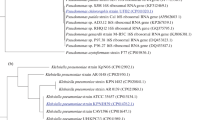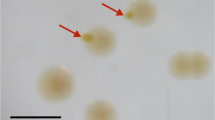Abstract
Pseudomonas marginalis, capable of utilizing acetonitrile as the sole source of carbon and nitrogen, was isolated from an industrial waste site. P. marginalis metabolized acetonitrile into ammonia and acetate. The minimal inhibitory concentration values of different nitriles and amides for P. marginalis were in the range 5–300 mM. The bacterium was able to transform high-molecular-mass nitrile compounds and their respective amides into ammonia. The data from substrate-dependent kinetics showed that the K m and V max values of P. marginalis for acetonitrile were 33 mM and 67 nmol oxygen consumed min−1 (ml cell suspension)−1 respectively. The study with [14C]acetonitrile indicated that nearly 66% of the carbon was released as 14CO2 and 12% was associated with the biomass. The enzyme system involved in the hydrolysis of acetonitrile was shown to be intracellular and inducible. The specific activities of the enzymes nitrile aminohydrolase and amidase were determined in the cell-free extracts of P. marginalis. Both the enzymes could hydrolyze a wide range of nitriles and amides. The present study suggests that the biodegradation of organic nitriles and the bioproduction of organic acids may be achieved with the cells of P. marginalis.
Similar content being viewed by others
References
Ahmed AE, Farooqui MYH (1982) Comparative toxicities of aliphatic nitriles. Toxicol Lett 12:157–163
Asano Y, Fujishiro K, Tani Y, Yamada H (1982a) Aliphatic nitrile hydratase from Arthrobacter sp. J-1. Purification and characterization Agric Biol Chem 46:1165–1174
Asano Y, Tachibana M, Tani Y, Yamada H (1982b) Purification and characterization of amidase which participates in nitrile degradation. Agric Biol Chem 46:1175–1181
Ashton FM, Crafts AS (1973) Mode of action of herbicides. Wiley, New York, pp 236–255
Henahan JF, Idol JD (1971) Setting the world of nitrile chemistry afire. Chem Eng News 49:16–18
Johannsen FR, Levinskas GJ, Berteau PE, Rodwell DE (1986) Evaluation of the teratogenic potential of three aliphatic nitriles in the rat. Fundam Appl Toxicol 7:33–40
Kaplan A (1969) The determination of urea, ammonia and urease. Methods Biochem Anal 17:311–324
Lowry OH, Rosebrough NJ, Farr AL, Randall RJ (1951) Protein measurement with the Folin phenol reagent. J Biol Chem 193:265–275
Nawaz MS, Chapatwala KD, Wolfram JH (1989) Degradation of acetonitrile by Pseudomonas putida. Appl Environ Microbiol 55:2267–2274
Nawaz MS, Davis JW, Wolfram JH, Chapatwala KD (1991) Degradation of organic cyanides by Pseudomonas aeruginosa. Appl Biochem Biotechnol 28/29:865–875
Palleroni NJ (1984) Gram-negative aerobic rods and cocci. In: Krieg NR, Holt JG (eds) Bergey's manual of systematic bacteriology, vol 1. Williams & Wilkins, Baltimore, pp 140–149
Rose IA (1955) Acetate kinase of bacteria (acetokinase). Methods Enzymol 1:591–595
Salame M, Nemphos SP (1973) The nature and properties of high acrylonitrile copolymer resins. In: Proceedings of the Symposium on Environmental Impact of Nitrile Barrier Container. Lopac: a case study. Monsanto, St Louis, pp 21–28
Schuchmann HP, Laider KJ (1972) Nitrogen compounds other than nitrous oxide in automobile exhaust gas. J Air Pollut Control Assoc 22:52–53
Shimp RJ, Larson RJ, Boethling RS (1990) Use of biodegradation data in chemical assessment. Environ Ecotoxicol Chem 9:1369–1377
Silva-Avalos J, Richmond MG, Nagappan O, Kunz DA (1990) Degradation of the metal-cyano complex tetracyanonickelate (II) by cyanide-utilizing bacterial isolates. Appl Environ Microbiol 12:3664–3670
Smibert RM, Krieg NR (1981) General characterization. In: Gerhardt P (ed) Manual of methods for general bacteriology. American Society for Microbiology, Washington, DC, pp 409–443
Yamada H, Asano Y, Hing T, Tani Y (1979) Microbial utilization of acrylonitrile. J Ferment Technol 5:8–14
Yamada H, Asano Y, Tani Y (1980) Microbial utilization of glutaronitrile. J Ferment Technol 6:495–500
Author information
Authors and Affiliations
Rights and permissions
About this article
Cite this article
Babu, G.R.V., Wolfram, J.H., Marian, J.M. et al. Pseudomonas marginalis: its degradative capability on organic nitriles and amides. Appl Microbiol Biotechnol 43, 739–745 (1995). https://doi.org/10.1007/BF00164782
Received:
Revised:
Accepted:
Issue Date:
DOI: https://doi.org/10.1007/BF00164782




